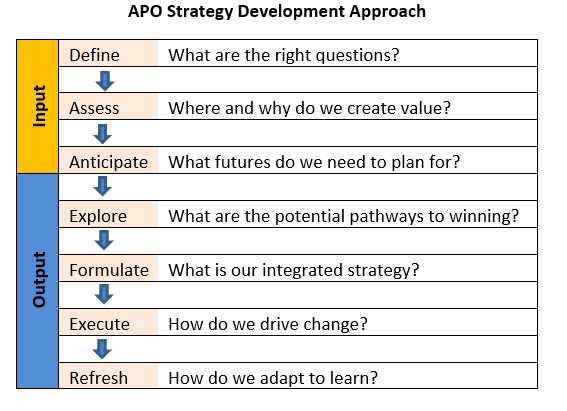
Select Page

That is a useful analogy to understand how organizations function while dealing with the impact of change. They can choose clear foresight and enjoy the journey to their goals or struggle with poor visibility. Unfortunately, when forced to look only in the rearview mirror, even the best drivers will always be going in reverse. If you are smart enough, you may reach your destination by changing your route, but cars are designed to go forward, not back. The inconvenience of driving while looking over your shoulder and the danger of crashing at high speed are additional worries.
The analogy also conveys a simple but important message: to move ahead in this fast-changing world, an organization needs to have a clear vision, foresight, and strategy to shape its future. An overall plan for setting strategies is vital. The process should not be based on assumptions but follow a systematic approach of scanning internal and external factors, their trends, and driving forces.
One of the key objectives of the APO is to transform itself and stay ahead of the curve to develop programs that can help member economies future-proof their productivity growth through inclusive, innovative, smart initiatives aligned with long-term national development goals. The upcoming Strategic Planning Workshop for NPOs in Tokyo will allow the APO and member countries to revisit fundamentals and traditional beliefs, as well as review, revise, and recreate a comprehensive picture of the strategic direction needed to drive productivity growth.
As a tactical shift to increase the effectiveness of the planning process, and as a first step in the new initiative, the APO Secretariat has decided on a complete change in the format of the annual Liaison Officers’ Meeting. The new format will help member countries clarify action plans to connect individual national needs to achieve the best outcomes.
While we intend to follow a seven-step process to create the APO Strategy Development Approach, as a run-up to the workshop, I will share the process in a series of blog posts in the next few weeks, with each post explaining a different step. The seven steps are: Define, Assess, Anticipate, Explore, Formulate, Execute, and Refresh.
The first three steps (define, assess, and anticipate) are part of the input phase since they answer the questions that form the basis of the strategic plan. The remaining four steps, explore, formulate, execute, and refresh, together form the output phase, since each leads to actions or forms part of a necessary action. The process is circular, as feedback from the refresh step will be utilized in the subsequent define phase during the 2018 Strategic Planning Workshop.
First step: define

The APO Strategy Development Approach follows the building-block model of McKinsey & Company and begins by asking the right questions to help identify meaningful target measures and a sequence of activities focusing on key efforts to put the strategy in place. The define phase will help the APO Secretariat and member countries “properly identify and agree on both the questions asked and the decisions made as the strategy is developed.” These predetermined issues include key objectives, productivity and technology challenges, capacity-building concerns, and strategic directions and approach, as well as the roadmap and development framework. For example, in the context of the APO, such predetermined issues involve Vision 2020 and existing plans. They can also cover the needs, expectations, and level of engagement of member countries in initiatives to support the less developed or developing ones in meeting the challenges of the fast-changing, dynamic global business environment. This will help the APO and NPOs keep their priorities straight and identify opportunities for improvement through cooperation and collaboration during the next five phases from assess to execute. In other words, the define phase will review predetermined organizational issues in the context of strategic objectives and goals.
Since the Strategic Planning Workshop will be attended by key influencers, planners, and decision makers from NPOs, the first step or define phase of the workshop will reconfirm the strategic plans and goals in the APO Roadmap to Achieve Vision 2020.
One of the key elements of effective strategy execution is measuring the results and impacts at each step for review and correction, if needed, for better results. The define phase as the first step will provide insight into the starting position, enabling all stakeholders to share a common view of where the APO stands as we begin the journey mapped out in the strategic development approach.
This will also ensure acceptability at national level and enable member countries to integrate their own strategies into overall APO operational plans. Together, we can then implement the new strategy while monitoring and reinforcing performance for a more productive future.